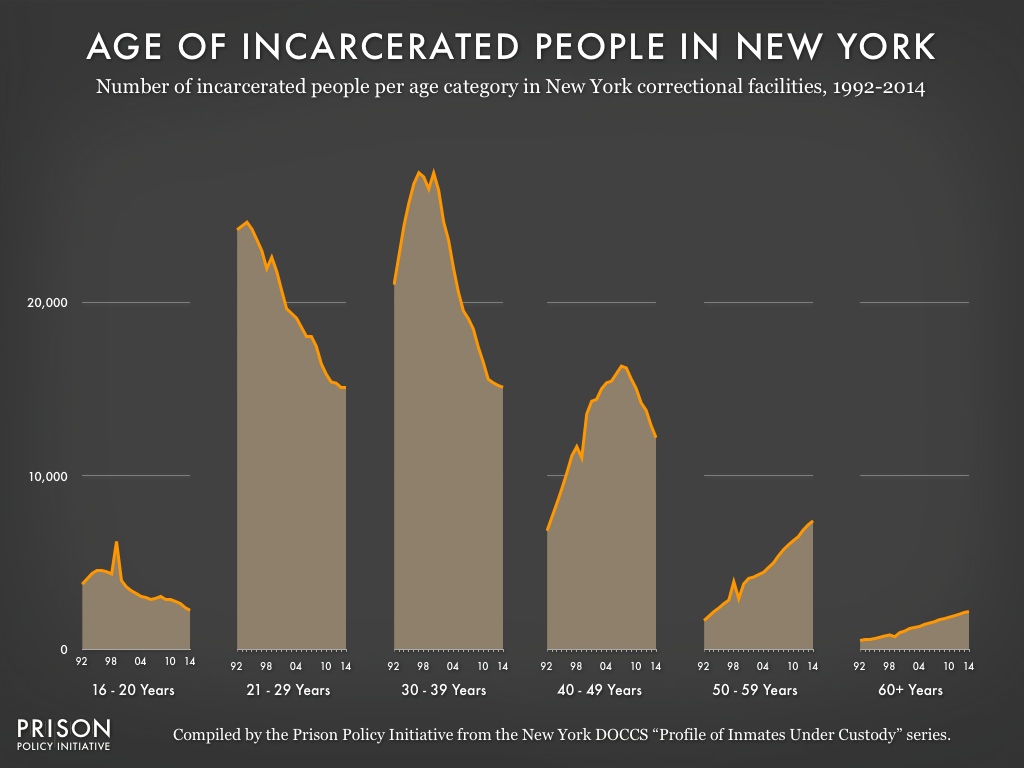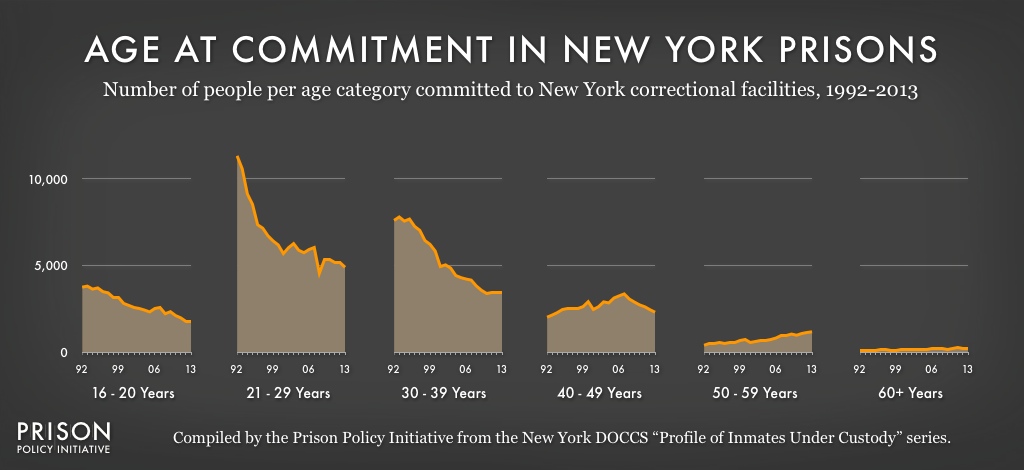What’s behind New York State’s elderly prison boom?
A failure to adopt sensible parole policies is driving New York State's elderly prison boom.
by Rachel Gandy, June 29, 2015
Over the last 15 years, New York managed to do what almost all other states couldn’t: it dramatically reduced its prison population. The reforms were wide-ranging, but they left one group behind—the elderly.
The rapid decline of all age groups under 50 years old and the rapid increase in people over 50 can be seen most clearly in this graph of the New York State prison population by age:
 While the number of people behind bars has fallen for most age groups, the number of people over the age of 50 incarcerated in New York State prisons is climbing. (While we do not have an explanation for the bump up or down for each age group in 1999, we do not consider it to be significant given the clarity of the larger trend.)
While the number of people behind bars has fallen for most age groups, the number of people over the age of 50 incarcerated in New York State prisons is climbing. (While we do not have an explanation for the bump up or down for each age group in 1999, we do not consider it to be significant given the clarity of the larger trend.)
While the number of people in prison under the age of 30 has been in almost constant decline since the mid 1990s, the number of incarcerated people in their 30s or 40s has been declining for about a decade. Throughout this period the number of people in prison aged 50 and older has been on a consistent and troubling rise.
There are only two possible explanations for this pattern:
- The elderly could be on a crime wave, driving the increase in older people behind bars. (Not true, as we explain below.) Or,
- Older people aren’t being released from prison.
The first theory of an elderly crime wave is easily disproved by the graph below showing the age of people sent to New York State prisons each year:
 The number of people sent to prison each year has been trending downward for all ages under 50 since at least 2007, and the number of people under age 40 sent to prison each year has been declining since the beginning of our data. To be sure, the number of people sent to prison in their 50s and 60s has been increasing, but the rate of growth is miniscule compared to the rapid growth seen in the incarcerated populations of these age groups in the previous graph.
The number of people sent to prison each year has been trending downward for all ages under 50 since at least 2007, and the number of people under age 40 sent to prison each year has been declining since the beginning of our data. To be sure, the number of people sent to prison in their 50s and 60s has been increasing, but the rate of growth is miniscule compared to the rapid growth seen in the incarcerated populations of these age groups in the previous graph.
The reason for this pattern unfortunately lies in the history of New York State’s sentencing laws and their current flawed parole practices. Many of the older people in prison have very long — but very old — sentences for violent offenses. And sadly, despite all of the other reforms, the parole board gives too much weight to the severity of the original offense, and too little weight to two key issues: people’s accomplishments while incarcerated and the low risks that elderly and infirm people pose to public safety.
Putting common sense back into parole decisions would be an excellent way to reduce the growing number of elderly people behind bars in New York State.
For further reading, see:
- Our 2014 article and interview with Mujahid Farid, founder of the Release Aging People in Prison (RAPP) Campaign.
- The Release Aging People in Prison Campaign website.




Ms. Gandy,
Thank you for bringing attention to this matter. With over 25 years of contact with in NYS prison populations, I have noted this trend for some time. May I offer some other possible reasons for older inmates lack of success at parole.
a) Their family members and those supporting them die off, or become to frail to fight the fight, as with the parolee him or herself.
b) Older inmates and their peers are not as likely to be computer savvy, denying them access to so much information that may be helpful. Such as the name of organizations you mention in your article.
Right now I am aware of a man almost 70 in bad health going to the parole board for the eight time next month. This after serving 23 years. – He was initially given a sentence of 15 years.
As the parole board itself has indicated on the record at the last five or six reviews, X is a model prisoner, having only had four minor infractions and the last over 10 years ago. That he has completed all his requirements to be released for deportation. And most importantly he has shown remorse and continues to be deeply remorseful for the reasons that brought him to prison in the first place. In short he is parole ready. And yet he continues to be denied parole.
[…] The same BJS report also discusses the very different causes of death in state prisons. In 2013, more than half of deaths in prison were of incarcerated people age 55 or older. Suicide is much rarer, and illnesses are the major cause of death for the aging prison population: […]